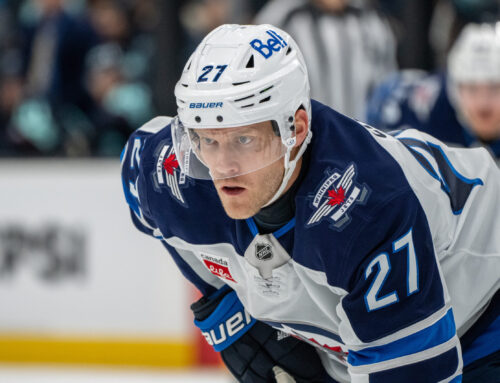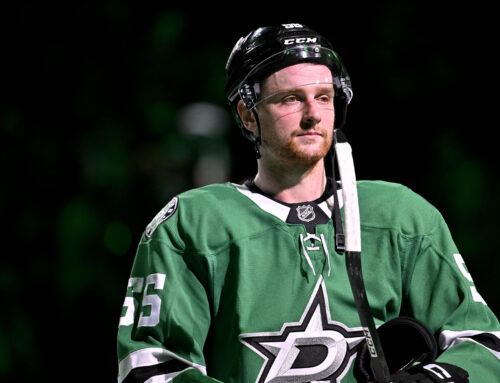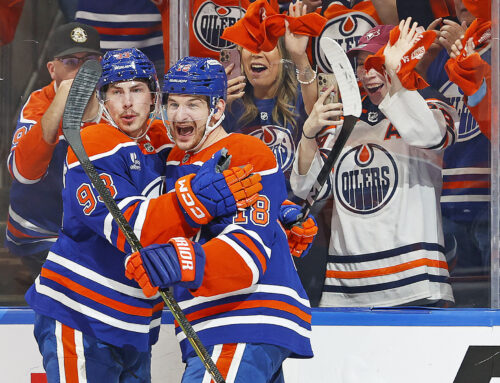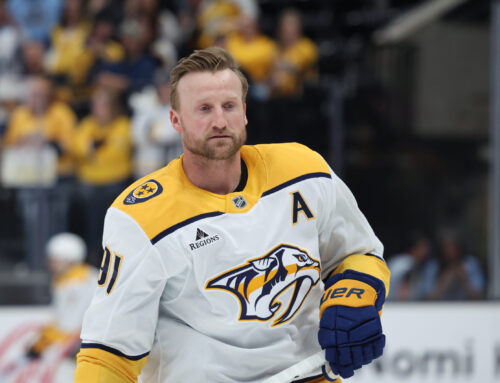With today’s column, I'm bridging a few topics to drafting, graduating draft picks and current prospect pools. The ideal scenario for a successful team should be having a high success rate for draft picks in general, graduating those draft picks to the NHL and continue to keep the pipeline going for future drafts by having a good prospect pool at any time.
For this purpose, I went back to 2010 and looked at each team's drafts to see how many players graduated per draft year using 100 NHL games as the benchmark from 2010 to the 2015 draft. From 2016 through 2020 I used 25 NHL games as the benchmark.
We are going to look team by team and see where each team in the West is currently ranked with their prospect pool, how they rank graduating players since 2016 and how they did from 2010-2015.
The reason I was interested in looking deeper is that I was curious if the teams that had better current prospect pools were a combination of good drafting and/or good prospects that just haven't graduated yet? And to ask what teams that had graduated well in the past five years, were still able to maintain a good stable of current players? From a fantasy standpoint, I'm very interested in what teams are developing players properly and what teams might be on the upswing in the three to five years that the prospects might see a productive window in the NHL. If a team hasn't developed well for the past 11 years, then they are unlikely to start now, unless they have cleaned the house.
Dobber Prospects is running their annual 32 in 32 columns in August and more in-depth prospect details will be available there.
NHL graduating average from 2010 to 2015: 12.8 grads on 41 picks (30.48%)
NHL graduating average from 2016 to 2020: 4.67 grads on 34.7 picks (13.48%)
NHL graduating average from 2010 to 2020: 17.1 grads on 75.45 picks (22.66%)
Anaheim Ducks (Organization Rank #2)
The Ducks have drafted well since 2010 and I was a little surprised to see that they graduated 18 of 39 picks (46.15% success) from 2010 to 2015, which is the best in the NHL in terms of both numbers of grads and percentage. The problem with this high number is that the Ducks didn't draft a real game-changing player in that time amongst some very good hits with Cam Fowler, Rickard Rakell, William Karlsson, Josh Manson, Hampus Lindholm, Frederik Andersen, John Gibson, Shea Theodore, Ondrej Kase and Brandon Montour. There is an argument to be made for Theodore but the Ducks essentially gave him away.
From 2016 to 2020 are the years I consider the period that most influences the current prospect pool. Of course, this doesn't take into account teams making a run for the Stanley Cup and trading high picks and prospects. I would assume that those teams will see their pools diminish and be nearer the bottom of the NHL than the top. The Ducks have graduated four of 33 draft picks in that period, good for a success rate of 12.12 percent which is good for 18th in the league. Both Trevor Zegras and Jamie Drysdale have played 24 NHL games and will be graduated very shortly adding to the Duck’s success but dealing a big blow to the quality of their prospect pool.
Overall from 2010 to 2020, the Ducks are number one in the NHL at 30.56 percent and tied for 4th in the NHL with 22 grads one behind the leaders at 23.
Arizona Coyotes (rank #19th)
From 2010 to 2015 the Coyotes graduated 11 of 40 draft picks (27.5%) which are good for 20th in the league. Much like the Ducks, Arizona had middling success with their draft picks through these years and picked some good but not great players in Max Domi, Christian Dvorak, Dylan Strome and perhaps Adin Hill.
From 2016 to 2020, Arizona has graduated four of 36 picks (11.11%) which is in the bottom ten in the NHL. The positive side to that is that Clayton Keller, Jakob Chychrun and Barrett Hayton were three of those picks and Chychrun is trending to be one of the better young defensemen in the league.
From 2010 to 2020, the Coyotes graduated 15 of 76 picks (19.74%) which is 23rd overall and not a great sign for a team that drafted fairly high for a few years.
Calgary Flames (rank #6)
The Flames were slightly below the NHL average between 2010 and 2015 with 11 graduates in 42 picks (26.19%) but boasted some very good picks in Johnny Gaudreau, Sean Monahan and Andrew Mangiapane. All three are still on the Flames and a big part of their lineup (for now).
From 2016 to 2020, the Flames graduated four of 32 picks (12.5%) so far with Matthew Tkachuk, Dillon Dube and Adam Fox. Tkachuk is one of the leaders on this team and Dube is emerging while Fox was included in the deal that brought Dougie Hamilton to Calgary.
Overall the Flames have graduated 15 of 74 picks (20.27%) which is about two graduates below average and might be a cause for concern with the Flames high ranking for a prospect pool that the Flames might not be that great at developing their players.
Chicago Blackhawks (rank #16)
Chicago graduated 15 of 55 draft picks from 2010 to 2015 (27.27%), slightly below average for percentage but made up for it with the most picks in the NHL in that period, so being above average in overall graduates. Some of their most notable picks were Kevin Hayes, Brandon Saad, Andrew Shaw, Philip Danault, Teuvo Teravainen and Nick Schmaltz. The Blackhawks rarely had picked in the top 20 so they did fairly well here.
From 2016 to 2020 the team has seven graduates from 40 picks (17.5%), which are all above average for the league. Alex Debrincat, Adam Boqvist and Kirby Dach are three of the most notable recent grads.
Overall from 2010 to 2020 has graduated 22 of a league-leading 95 draft picks (with Detroit) good for a 23.16% success rate. They are about five graduates and 20 draft picks above average. Chicago drafts and develops well and is a team that believes in stockpiling picks.
Colorado Avalanche (rank #26)
From 2010 to 2015, Colorado graduated only seven players on 39 picks (17.95%) which puts them bottom of the league in percentage and tied for the bottom in graduates with the NY Rangers for that period. Fortunately for the Avalanche, they were able to get Gabriel Landeskog 2nd overall in 2011, Nathan MacKinnon 1st overall in 2013. Other notables are Will Butcher and Mikko Rantanen. Colorado didn't hit it often but they hit it out of the park three times.
They haven’t improved their development from 2016 to 2020 so far with four graduates from 34 picks (11.76%) which are both slightly below average. Cale Makar looks like another home run as he was selected 4th overall in 2017 along with Tyson Jost, Bowen Byram and Alex Newhook who I would consider graduates, but not yet for this exercise.
This was not what I was expecting when looking at Colorado as overall they have only graduated 11 players on 73 picks (15.07%). The number of graduates ties them for last in the NHL with Minnesota and their success rate puts them in the basement by themselves. The perception is that the club was built on the draft, but it might be a cautionary tale as maybe they wouldn't be where they are with all the top four picks they have hit on.
Dallas Stars (rank #15)
The Stars graduated 15 of 44 draft picks from 2010 to 2015 good for a 34.09% success rate, which puts them just above average in all categories. Some good picks during this period were John Klingberg, Jamie Oleksiak, Esa Lindell, Radek Faksa, Roope Hintz and Denis Gurianov (this one took a while).
From 2016 to 2020, Dallas has six grads from 30 picks good for 20% which is 4th in the NHL. Some notable players are Miro Heiskanen, Jason Robertson and Jake Oettinger.
Overall The Stars have 21 players from 74 draft picks (28.38%), which is about four players who graduated above average and about six percent higher than the rest of the league. They are a very good team that develops well on the fly and has stayed relatively competitive throughout.
Edmonton Oilers (rank #12)
We know without even looking at any details that the Oilers were successful between 2010 and 2015 because they drafted Connor McDavid and Leon Draisaitl. The numbers show 15 players on 52 picks (28.85%) which is below average percentage-wise but about three players and 10 picks above average. There is no excuse for this team to be below average with first overall picks in 2010, 2011, 2012 and 2015. Other notables other than the above are Oscar Klefbom, Darnell Nurse, Niall Yakapov, Taylor Hall, Ryan Nugent-Hopkins and John Marino. It is well documented that the Oilers wasted a lot of their good fortune during this period in the next period.
From 2016 to 2020 the Oilers have graduated only two players from 33 draft picks (6.06%) which put them in the bottom portion of the league. Jesse Puljujarvi and Kailer Yamamoto are the two players in question and should be joined this season by Evan Bouchard.
Overall Edmonton has developed 17 players on 85 picks (20%) which would be potentially tragic without the top 10 picks they have been very fortunate to have had.
Los Angeles Kings (rank #1)
For the team that has perhaps the highest-ranked prospect pool, it will be interesting to see what they have done since 2010.
From 2010 to 2015 the Kings graduated 12 players from 38 draft picks (31.58%) all right around the league average. Some of the notable players were Tyler Toffoli, Derek Forbort, Colin Miller, Tanner Pearson, Dominik Kubalik, Adrian Kempe and Erik Cernak.
From 2016 to 2020 they have had four players make it from 36 draft picks (11.11%) which are just slightly below league average. The four players are Gabriel Vilardi, Mikey Anderson, Jarret Anderson-Dolan and Tobias Bjornfot. The team has had some picks in the top five in 2019 and 2020 with Alex Turcotte and Quinton Byfield chosen has put the Kings in an envious position. There has to be some concern that their track record has not been that great over the past 11 years and expectations might be tempered.
Overall the team has 15 players from 74 draft picks (20.27%) which are about two players less than the average.
Minnesota Wild (rank #3)
During the years from 2010 to 2015, the Wild had 10 grads on 38 draft picks (26.32%) which is about three players below average on about four picks less than average. Some of the notable picks for the Wild were Mikael Granlund, Jason Zucker, Jonas Brodin, Matt Dumba, Alex Tuch, Kirill Kaprizov, Jordan Greenway and Joel Eriksson-Ek. They have made the most of their successes here.
From 2016 to 2020, Minnesota has only graduated one player from 30 draft picks and believe it or not that isn't even the worst result in the NHL for that period (Pittsburgh is 0 for 26 and Washington is 0 for 27). Luke Kunin is the only player that has graduated to the NHL and the Wild traded him to Nashville.
Overall the Wild are tied for the least amount of grads with 11 of 68 draft picks (16.18%). This works out to almost six fewer players than the average on about eight fewer picks on average. It goes to show that even when a team struggles for two or three years at the draft table (2016-2018), they can refill the cupboards in two or three years (2019-2021). Or there is a chance that other than Matthew Boldy, Marco Rossi and Jesper Wallstedt, the prospect pool might be overstated a little.
Nashville Predators (rank #10)
The draft, player development and prospect pool used to be the bread and butter of the Predator’s success during the early 2000s but has struggled a little of late.
From 2010 to 2015, Nashville had 13 players come into the league on 47 draft picks (27.66%) which are close to the league average, something they weren't used to being. Some notable picks were Austin Watson, Colton Sissons, Jimmy Vesey, Juuse Saros, Seth Jones, Viktor Arvidsson and Kevin Fiala. A franchise renowned for developing defensemen had Seth Jones and traded him for Ryan Johansen.
From 2016 to 2020, the Predators have only had three players from 33 draft picks graduate (9.09%) which is well below average. The team did pick some defenders in Samuel Girard and Dante Fabbro but traded Girard and the jury is still out on Fabbro. The other player is Eeli Tolvanen who had his doubters as well but appears to be back on track after last season.
Overall Nashville has had 16 players from 80 draft picks emerge, which are both right around the league average.
With two first-round picks in 2021, the Predators are looking to restock their prospect pool and get back on track with what got them where they were.
San Jose Sharks (rank #5)
It's a good thing the Sharks appear to have a good prospect pool as they are aging, overpaid roster that is in decline.
From 2010 to 2015, San Jose had 13 players from 40 draft picks (32.5%) which are right at the league average. Some notable players from this time were Charlie Coyle, Chris Tierney, Matt Nieto, Tomas Hertl, Kevin Labanc and Timo Meier.
During the period between 2016 and 2020, the Sharks had five players come up from 30 draft picks (16.67%). The grads that emerged were just above average but the number of picks was about five picks below. Dylan Gambrell, Noah Gregor, Mario Ferraro, Josh Norris and John Leonard are the five so far, but there is some quality on the way with William Eklund picked in 2021.
Overall the team had 18 players from 70 picks (25.71%) and is slightly above the league average.
St. Louis Blues (rank #25)
The Blues had 14 players from 45 draft picks (31.11%) graduate between 2010 and 2015, which are both league average. Looking at some of the players and it's easy to see the role they played in the Stanley Cup win in 2019 as the team added Jaden Schwartz, Vladimir Tarasenko, Jordan Binnington, Joel Edmundson, Colton Parayko, Vince Dunn and Ivan Barbashev in that period.
From 2016 to 2020 the team only had three players from 32 draft picks (9.38%) graduate so far and those players were Tage Thompson, Jordan Kyrou and Robert Thomas. It is not a great sign that the prospect pool is ranked so low with these few players having come into the NHL.
Overall the Blues have seen 17 players from 77 picks (22.08%) which is almost dead on the league average.
Vancouver Canucks (rank #23)
The Canucks only had eight players from 38 draft picks (21.05%) emerge from 2010 to 2015. They were about five players below average which is noticeable in a six-year window. This isn't overly surprising as they were a very competitive team up until 2013. Some of the notable players from that period were Ben Hutton, Bo Horvat, Gustav Forsling, Thatcher Demko, Jake Virtanen, Jared McCann and Brock Boeser. Mistakes were made.
From 2016 to 2020 the team has three graduates on 34 draft picks (8.82%) so far who are Elias Pettersson, Quinn Hughes and Nils Hoglander. The quality is high with Pettersson and Hughes but they can't do it alone.
Overall the Canucks only have 10 players from 72 draft picks (13.89%) all of which are well below league average. The team is almost seven players below the average of having graduated NHL players over the 11 years but they are only three picks below average. Player development has not been a strong suit of this team for several years.
Winnipeg Jets (rank #22)
On the surface, it appears that the Jets have built from within over the past 11 years but let’s have a closer look.
From 2010 to 2015 the team had 12 grads from 45 draft picks (26.67%) which are around the league average. Some of the notable picks for the Jets were Mark Scheifele, Adam Lowry, Jacob Trouba, Connor Hellebuyck, Andrew Copp, Josh Morrissey, Nik Ehlers, Mason Appleton, Jack Roslovic and Kyle Connor. That is some pretty impressive additions to the roster from the 12 players.
In the period from 2016 to 2020, the Jets have two graduated players from 29 draft picks (6.9%) with the two being Patrick Laine and Logan Stanley. This is well below average but the team has perhaps two or three players that will be included after this next season.
Overall, Winnipeg has 14 players from 74 draft picks (18.92%) which are about three players below normal. The Jets have been one of the better teams at developing their players for the top roles in their lineup.
There are a few scenarios that I didn't touch on here. If a player was drafted and traded, unless otherwise noted, I assume that the original team got similar value in return for the player traded, so it still counts as a drafting, development success story. I didn't delve too much into player quality, as that would take too much time and difference of opinion. I've tried to list the players taken if noteworthy and people can draw their own opinions on what is a successful graduate or not.
Thank you very much for reading and if you have any comments or suggestions please message me or follow me on Twitter @gampbler15.





 BUF
BUF NYR
NYR CHI
CHI EDM
EDM CBJ
CBJ S.J
S.J VAN
VAN ANA
ANA MIN
MIN
